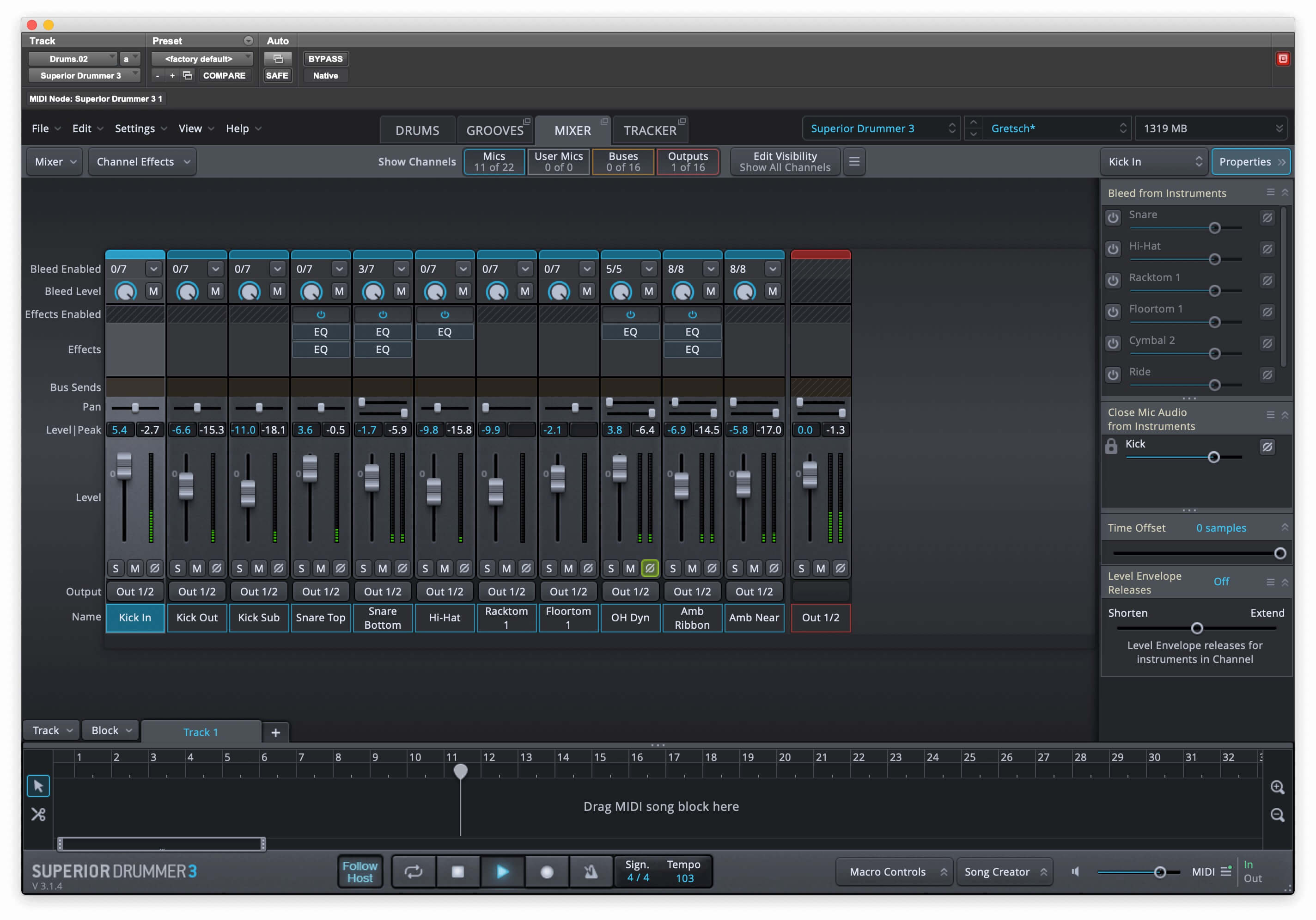Engineers use a variety of processing and miking techniques to get a little extra mojo into multitrack drum sounds. In this excerpt from the Vance Powell Start to Finish Series Episode 3, Vance demonstrates his “Sprinkle to Taste Mic (hereafter referred to as “STTM”), whose output he processes and brings back into the drum mix to spice it up.
The mic is an old Ampex 1101, which is a dynamic mic, designed initially for tape recorders, but which became a desired mic for harmonica players. It’s the type of mic that harp players plug into amps onstage to get a distorted sound. But here, Vance is using it on the kit, placed under the snare next to the floor tom of Illiterate Light drummer Jake Cochran’s unusual drum kit.

Vance’s placement of his Sprinkle to Taste Mic.
On the Path
We begin with Vance listening to the sound of the STTM mic soloed and talking about the effects he will apply to it using a channel insert on his console.
He sends the output of the STTM mic through a Radial EXTC 500, which is a 500-series module that allows you to use unbalanced, instrument-level guitar effects pedals with balanced line-level signals from a console (it’s also a reamping box).

The Radial EXTC allows you to insert unbalanced, high-impedance sources (such as guitar pedals) into a console or audio interface.
The next stop in the chain is a Pigtronix Polysaturator, which is a guitar overdrive pedal. After that, the signal goes into a pedal called BeardVerb, which Vance explains is actually an analog delay that was custom built for him.
He plays the channel soloed, and it sounds trashy, but in a good way. Overdrive and distortion pedals, in particular, can create a lot of noise, usually buzz, so Vance activates the noise gate for that channel on the console.

Here you can see the whole effects chain for the insert (on the left side of the wall-mounted pedals).
Now he turns the solo off, so you hear the rest of the drum mics along with it. He switches the STTM in and out of the mix in order to compare the sound. With it in, the drums have a livelier, looser sound.
Finally, he checks to see if the STTM is in phase with the other drums. Vance asks Jake to hit the snare a few times, and then he flips the phase switch on the API mic pre he’s using for that channel. He decides that it sounds better out of phase.
What’s it Doing?
Vance uses his STTM to capture a perspective of the whole kit—it’s not aimed at a specific drum. The idea is not all that different from someone using a really cheap mic as a room mic and overloading it to get distortion, although the STTM is underneath the kit, rather than back from it.
When you first hear it without the effects, the drums and cymbals sound pretty thin. When Vance adds the overdrive and delay, it sounds compressed (distortion compresses the signal) and trashy, and he dials it into the kit like you would with parallel saturation or compression.
Yes, You Can
If you’re miking a multitrack drum kit, you can try to recreate something similar to Vance’s STTM. You might get lucky and find a used Ampex 1101, or you could try using another inexpensive dynamic mic. But if you’re working with drum loops or virtual drum instruments, you can create a similar effect using a duplicated drum track and plug-ins.

The mixer of Superior Drummer 3 allows you to mix and mute individual drum mics from their original sampling session.
The following examples use Toontrack Superior Drummer 3, a sampled MIDI virtual drum instrument.
EX 1: Here’s a basic, pretty clean sounding drum pattern.
Instead of an additional mic on the kit like Vance used, the drum track was duplicated and some of the individual drum mics in Superior Drummer 3’s mixer were turned off to more closely emulate the thin sound of the Ampex mic.
EX 2: This is the duplicated track with some of the mics muted but no added effects.
EX 3: Here’s the duplicate track with a McDSP EC300 delay in Analog mode, set to a very short 50ms delay with the mix control quite low. Listen to the snare in particular to hear the difference.
EX 4: Distortion and compression we’re added using the brand new plug-in called Autoformer, from Soundevice Digital (United Plugins). It’s providing a similar effect to what Vance got from the Polysaturator pedal.
EX 5: For some additional distortion, another new plug-in, Waves MultiMod Rack, which allows you to create multiband saturation effects with various Waves distortion and overdrive plug-ins, was added. The patch used featured three instances of Waves Abbey Road Saturator plug-in.

Soundevice Digital Autoformer from United Plugins (left), and Waves MultiMod Rack (right) loaded with Abbey Road Saturator plug-ins, were used for distortion and compression.
EX 6: The first four measures don’t have the duplicated “STTM” track, the last four do.
Now, let’s listen in context.
EX 7: Here, you’ll hear the drum part with bass and rhythm guitar added. Again, for the first four measures, it’s only the original drum track. For the final four, the duplicated trash track is brought in.